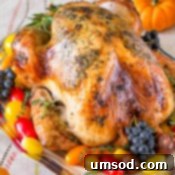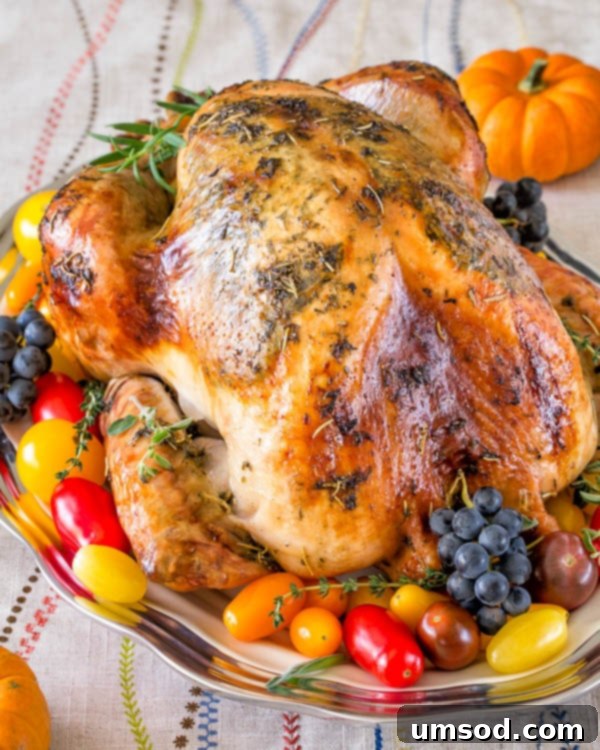Get ready to revolutionize your holiday meal with a roast turkey recipe so incredibly juicy and flavorful, it will make you the undisputed hero of any Thanksgiving dinner. Forget the messy, time-consuming brining process; my secret involves a bottle of sparkling champagne and rich melted butter, guaranteeing a moist, tender bird every single time. Seriously, once you try this no-brine method, you’ll never look back!
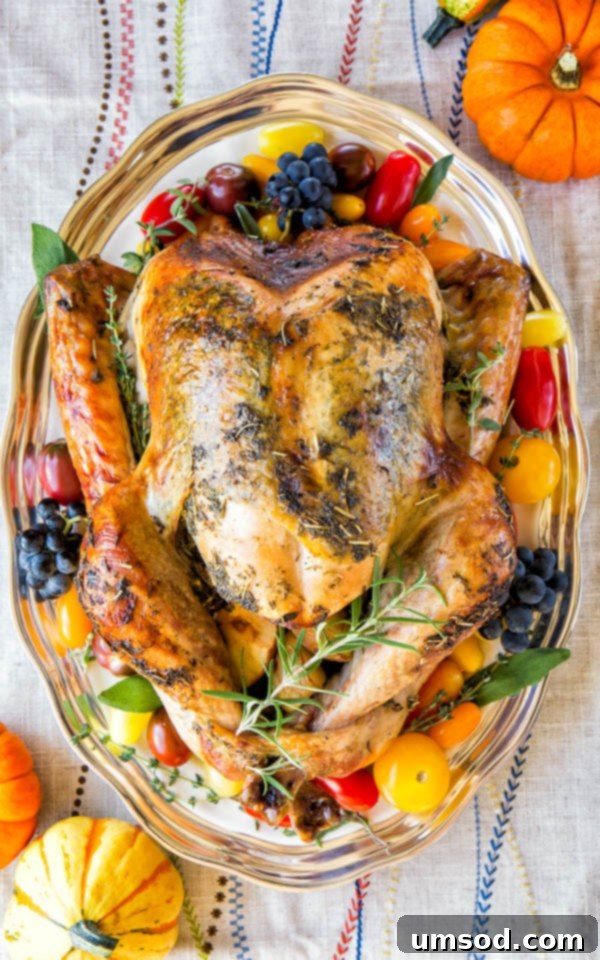
Unlock the Secret to the Juiciest No-Brine Roast Turkey
You heard that right – this year, we’re ditching the brine. For many years, preparing our Thanksgiving turkey meant my husband dutifully bringing out a massive bucket and meticulously concocting his brining solution to soak our bird. While his efforts always resulted in a deliciously juicy turkey, the entire process was undeniably cumbersome and occupied significant refrigerator space for days.
My curiosity grew: could we achieve that same succulent, tender turkey without the hassle of traditional brining? This year, I decided to embark on an early culinary experiment, driven by a desire to simplify the holiday prep without compromising on flavor or moisture. The quest for a truly effortless yet spectacular roast turkey began, and I’m thrilled to share the game-changing discovery.
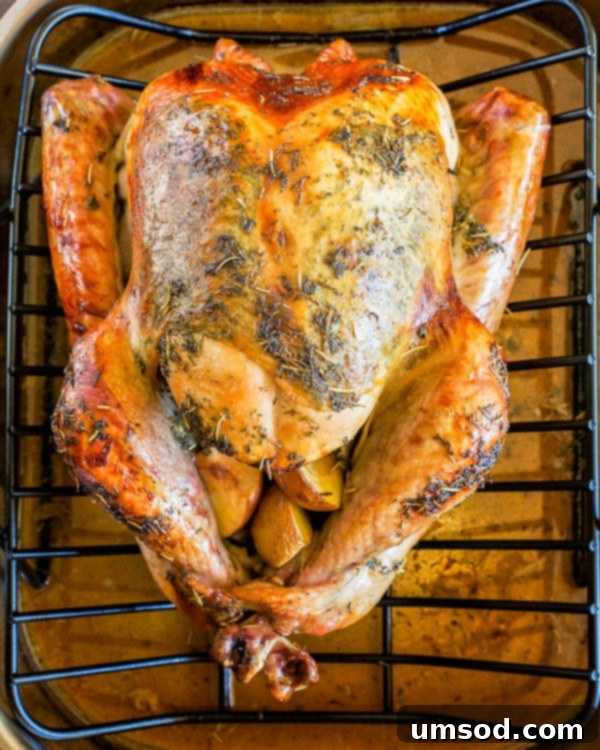
The real catalyst for this culinary adventure came from an intriguing method I stumbled upon in a past issue of Real Simple magazine (November 2016). It proposed an innovative technique: injecting a brining solution or, even better, melted butter directly into the turkey’s breast and legs before roasting. The idea of bypassing the large brine bucket and infusing moisture and flavor from the inside out sounded incredibly promising and remarkably simple.
Sounds intriguing, doesn’t it? I wasted no time in putting this method to the test, and I am absolutely delighted to report – *it works wonders*! My initial trials focused on injecting pure melted butter, as I planned to generously season the turkey’s exterior with a medley of fresh herbs. However, the possibilities are endless! Next time, I’m eager to experiment with herb-infused melted butter, or even a rich, nutty brown butter for an extra layer of gourmet flavor. This internal moisturizing technique truly transforms the turkey, ensuring every bite is moist and tender.
For this ingenious method, you’ll need a reliable marinade injector. You’ll fill it with your melted butter and carefully inject it into the meat prior to roasting. While this technique is fantastic, exercise caution: avoid over-poking the bird, as too many punctures can damage the skin, affecting both appearance and crispiness. I demonstrate the precise technique in the video further down the page, but here’s a quick visual overview to guide you. It’s simpler than you might think!
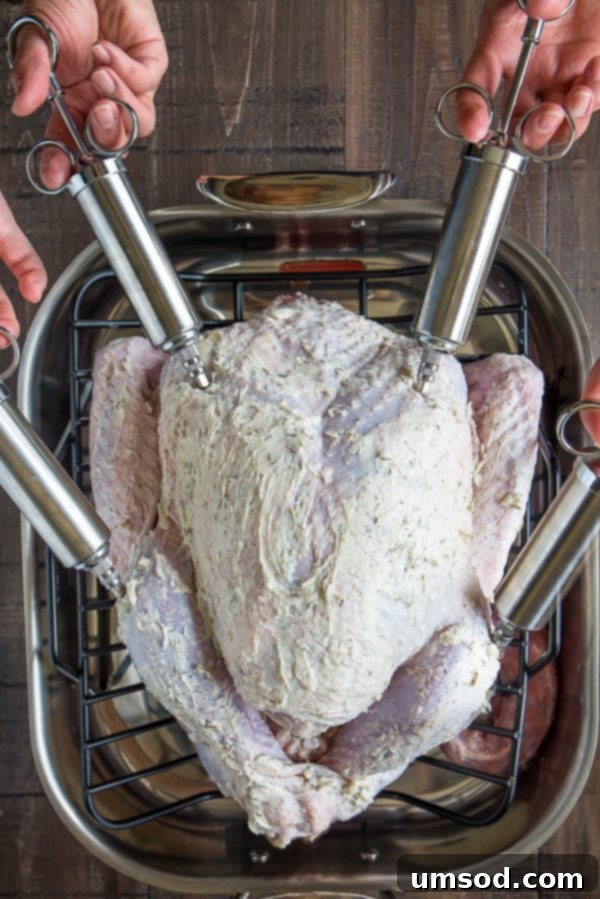
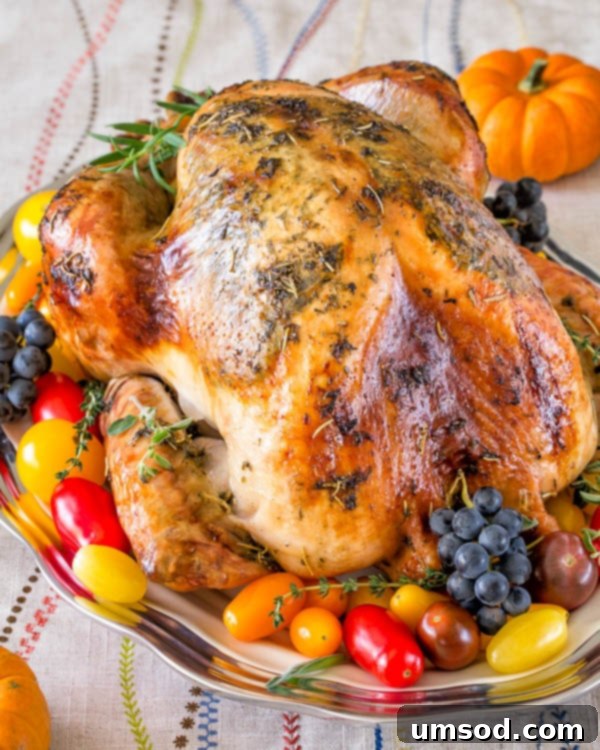
And that’s not the only innovative technique employed in crafting this extraordinary Thanksgiving turkey recipe. This roast turkey is truly exceptional because it’s also roasted in champagne! Yes, you read that correctly. Beyond merely adding an elegant touch to your holiday spread, the champagne plays a crucial role in enhancing both flavor and moisture. This unique approach elevates a classic dish into a truly memorable culinary experience, promising a turkey that is not just juicy, but bursting with sophisticated flavor.
Key Ingredients for Your Champagne Roast Turkey
- Whole Turkey: When planning, estimate about 1.5 pounds of turkey per person to ensure ample servings and delicious leftovers. For this recipe, the beauty is that you don’t need to brine your turkey beforehand! It’s perfectly fine if your turkey is kosher or has already been injected with a saline solution; the internal butter injection will still significantly enhance its moisture and flavor.
- Unsalted Butter & Seasonings (Compound Butter): Butter is the foundation of flavor and moisture. We’ll create a rich compound butter by blending softened unsalted butter with an array of aromatic herbs and spices. Feel free to customize this with your favorite herb combinations, or even try browning the butter first for a deeper, nuttier flavor profile.
- Fresh Lemon Juice: A squeeze of lemon juice adds a crucial touch of acidity to the compound butter. This not only brightens the overall flavor of the turkey but also acts as a natural tenderizer, helping to break down muscle fibers for an even more tender result.
- Aromatics for the Cavity (Apples, Carrots, Fresh Herbs): Filling the turkey cavity with a selection of fruits and vegetables like apples and carrots, alongside fresh herbs such as rosemary and thyme, infuses the bird with incredible aromatic flavors from the inside out. Other excellent choices include oranges, lemons, onions, or celery. These aromatics contribute to a complex, savory flavor profile.
- Champagne: This is the star secret ingredient that sets this recipe apart! You don’t need an expensive vintage; an affordable brut champagne, like Korbel Brut, works perfectly. As the turkey roasts, the champagne concentrates, creating the most exquisite, tangy, and deeply flavorful pan drippings imaginable. This liquid bath also continuously bastes the bird, ensuring it stays wonderfully moist throughout the cooking process.
- Chicken Broth or Stock: Used in conjunction with the champagne in the roasting pan, chicken broth adds another layer of savory depth to the pan drippings, contributing to a richer and more balanced flavor for your gravy. Both broth and stock will yield excellent results.
The addition of champagne not only contributes an unparalleled tang and depth to the pan drippings, which are foundational for an extraordinary gravy, but it also consistently bathes the bird, keeping it incredibly moist and succulent. This subtle effervescence and fruity acidity infuse the turkey with a refined flavor that is truly unique.
I must extend my gratitude for the initial inspiration behind this method to this highly-rated recipe on Allrecipes.com. It has garnered countless rave reviews, and rightly so!
Crafting the Ultimate Juicy Turkey: Step-by-Step Instructions
Achieving a perfectly roasted, juicy turkey without brining is simple with these detailed steps. Follow along to prepare a Thanksgiving centerpiece that will impress everyone.
Phase 1: Turkey Preparation
- Thawing Your Turkey: Begin thawing your frozen turkey in the refrigerator approximately 2-3 days before you plan to roast it, allowing ample time for it to fully defrost safely.
- Remove Giblets: Carefully remove the neck and giblets from both cavities of the turkey. These can be saved for making stock or gravy, or discarded.
- Thoroughly Pat Dry: This step is crucial for crispy skin and proper butter adhesion. Use paper towels to thoroughly pat the entire surface of the turkey dry, inside and out. Ensure there is no residual moisture.
- Create a Skin Pocket: Gently slide your hand under the breast skin, starting from the cavity opening, to carefully separate the skin from the breast meat. This creates a pocket where the compound butter will be applied, ensuring maximum flavor and moisture directly to the meat.
Phase 2: Flavor Infusion
- Prepare the Compound Butter: In a small mixing bowl, combine 1 stick of softened unsalted butter with grated garlic (about 4-5 cloves), 2 teaspoons of dried parsley, 1 teaspoon of ground dried rosemary, 1 teaspoon of rubbed dried sage, 1 teaspoon of dried thyme leaves, 1 tablespoon of salt, and the juice of 1 lemon. Mix these ingredients until they are well combined. It’s okay if the lemon juice isn’t fully incorporated; the flavors will meld during roasting.
- Season the Turkey Generously: Take the prepared compound butter and smear it evenly all over the exterior of the turkey, as well as under the breast skin in the pocket you created. Ensure every part of the bird is coated for maximum flavor and browning. Remember: if the skin is wet, the butter won’t adhere properly, so a dry surface is key!
- Position the Turkey: Place the seasoned turkey, breast-side up, on a V-rack set in a large roasting pan. This ensures even air circulation and helps crisp the skin.
- Stuff the Cavity with Aromatics: Fill the turkey cavity with the roughly chopped apples, carrots, and a bunch of fresh herbs like rosemary, thyme, and marjoram. These aromatics will infuse the turkey with their delightful scents and flavors as it roasts.
- Tie the Legs (Optional): If desired, use kitchen twine to loosely tie the legs of the bird together. This helps the turkey cook more evenly and results in a neater presentation. I find this method simpler and more effective than full trussing for this recipe.
- Melt Butter for Injection: Melt the remaining 4 tablespoons of unsalted butter in a small bowl.
- Inject for Ultimate Moisture: Using a marinade injector, carefully and slowly inject about 1 tablespoon of the melted butter into each thigh and each breast half. Aim to inject deep into the muscle, distributing the butter evenly to keep the meat incredibly moist from the inside out.
Phase 3: Roasting and Resting
- Prepare Roasting Pan Liquid: Pour the entire bottle of champagne and 2 cups of chicken stock over the turkey and into the roasting pan cavity. This liquid bath will create a flavorful steaming environment and be the base for your exquisite gravy.
- Roast to Golden Perfection: Preheat your oven to 350°F (177°C). Roast the turkey until it achieves a beautiful golden-brown color and is thoroughly cooked through. For a 14-pound turkey, this typically takes about 3.5 hours. Baste the turkey every hour using a turkey baster, ensuring consistent moisture and even browning. If the skin is browning too quickly after about 2 hours, loosely cover the breast with aluminum foil to prevent over-browning. Conversely, if browning is too slow, increase the oven temperature by 50°F (10°C) for a short period.
- Check for Doneness: The turkey is safely cooked when the deepest part of the breast and legs registers an internal temperature of 165°F (74°C) on an instant-read thermometer. Always check in multiple spots to ensure even cooking.
- Crucial Resting Period: Once cooked, remove the turkey from the oven, loosely cover it with foil, and let it rest for a minimum of 30 minutes before carving. This resting period is vital, allowing the juices to redistribute throughout the meat, resulting in an exceptionally tender and moist turkey.
Expert Tips for a Flawless Roast Turkey
What to Put Inside a Turkey for Maximum Moisture
Beyond the pan liquid, the secret to an extra moist and flavorful turkey lies in injecting the breast and thighs with melted butter. This infuses the meat directly, ensuring every bite is succulent and rich. Additionally, stuffing the cavity with aromatic vegetables and herbs like apples, carrots, rosemary, and thyme adds internal moisture and a fragrant depth of flavor that permeates the entire bird.
How to Season Your Turkey for Best Flavor
Compound butter is an unparalleled method for seasoning your turkey, providing both flavor and a beautiful golden crust. For the most profound flavor, I highly recommend rubbing a generous amount of this herb-infused butter not only over the skin but also directly under the breast skin, where it comes into contact with the meat. This ensures the savory herbs and spices penetrate deeply, seasoning the turkey from within.
How Long to Roast Your Turkey
Roasting times vary based on the size of your turkey and whether it is stuffed or unstuffed. Generally, an unstuffed turkey roasted at 350°F (177°C) will take approximately 2.5 to 5 hours. For example, a 14-pound turkey typically roasts for about 3.5 hours until golden brown and cooked through. If you choose to stuff your turkey, you’ll need to add an additional 15-30 minutes to the total roasting time, ensuring the stuffing also reaches a safe internal temperature of 165°F (74°C).
Maintaining Turkey Moisture During Roasting
The primary method for keeping this turkey exceptionally moist and juicy is the internal injection of melted butter. This method locks in moisture from the inside. Additionally, basting the turkey every hour with the flavorful pan juices (a mixture of champagne and chicken broth) helps to keep the skin from drying out and encourages even browning, creating a flavorful and visually appealing crust.
Serving Your Magnificent Oven-Roasted Turkey
Once your oven-roasted turkey has completed its essential resting period of at least 30 minutes, it’s ready to be presented. You have two elegant options for serving: you can showcase the whole, beautifully roasted turkey on a grand serving platter, perhaps garnished with fresh herbs, vibrant fruits like cranberries and orange slices, or an assortment of roasted vegetables for a stunning centerpiece. Alternatively, for easier serving and guest convenience, you may carve the turkey beforehand, arranging the slices artfully on a platter. Whichever method you choose, your guests will be delighted by its tender juiciness and rich flavor.
Champagne Roast Turkey Recipe FAQs
Generally, I do not cover the turkey when roasting, as I aim for a beautiful, crispy golden-brown skin. However, if I notice the breast skin beginning to brown too quickly or excessively, I will simply place a small sheet of aluminum foil over that area to shield it and prevent over-browning while the rest of the turkey finishes cooking.
While it’s not strictly required to add plain water to the bottom of a roasting pan, for this champagne roast turkey recipe, I highly recommend adding chicken broth along with a bottle of champagne. This creates the most incredibly flavorful pan drippings, which are absolutely essential for making a truly unforgettable gravy.
Now, I must issue a delightful warning about those tangy pan drippings. Because the champagne significantly reduces during the roasting process, its flavors become wonderfully concentrated, resulting in drippings with a distinct, exquisite tang. But, and this is a big “but” – if used carefully, these drippings will transform your gravy into something truly extraordinary, a condiment that will be “to die for”!
And I’m not exaggerating. We’re not talking about the usual, often predictable turkey gravy here. While there’s nothing wrong with a tried-and-true gravy, let’s be honest, it can sometimes be a little… boring. What we’re creating here is a bold, intensely flavorful turkey gravy that will become the star of your table, circulating non-stop. I speak from experience: when we hosted our “faux-Thanksgiving” in September, I had to get up and refill the gravy bowl an astounding four times! It was that utterly delicious and addictive!
When I say “use the drippings carefully,” I mean to incorporate them into your gravy little by little, adjusting to your taste. The concentrated flavors are potent, so a gradual addition allows you to achieve the perfect balance. You can find the complete gravy recipe here, which provides detailed instructions for mastering this magnificent sauce.
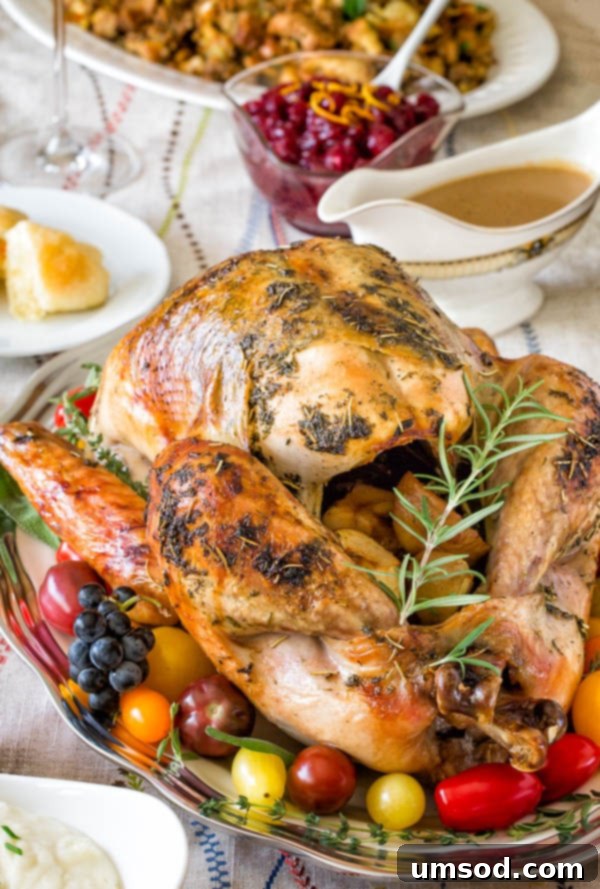
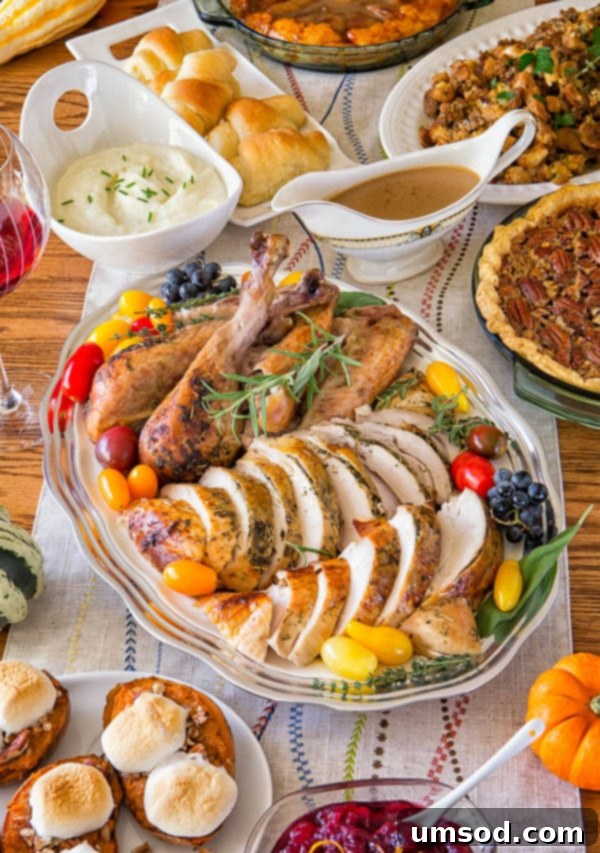
Now, I encourage you to go forth and give this incredible recipe a test run before the big holiday gathering. Sharing your feedback and experiences would be greatly appreciated. Happy cooking, and thank you!
Watch Video: How to Roast a Turkey
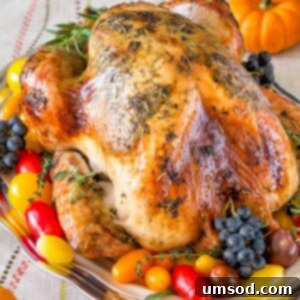
Oven Roasted Turkey Recipe
Comment
Print Recipe
Ingredients
- 1 whole turkey (I used 14lbs turkey)
- 1 ½ sticks (170g) unsalted butter softened, divided
- 1 tablespoon grated garlic (about 4-5 cloves) Note 1
- 2 teaspoons dried parsley
- 1 teaspoon ground dried rosemary
- 1 teaspoon rubbed dried sage
- 1 teaspoon dried thyme leaves
- 1 tablespoon salt
- Juice of 1 lemon
- 3 apples cored and roughly chopped, optional
- 2 large carrots roughly chopped, optional
- A bunch of fresh herbs like rosemary, thyme, marjoram
- 1 bottle (750ml) champagne
- 2 cups chicken broth
Instructions
- Begin to thaw the turkey in the refrigerator 2-3 days before roasting.
- Preheat the oven to 350°F (177°C).
- Pull the neck and giblets out of the cavity. Pat dry the turkey with paper towels. Carefully run your hand under the breast skin to create a pocket.
- In a small mixing bowl, combine 1 stick of butter, garlic, parsley, rosemary, sage, thyme, salt and lemon juice. Mix until well combined.
- Smear the butter evenly all over the turkey and under the breast skin. (If the skin is wet, butter won’t stick. So make sure to dry the skin with paper towel well.) Place the turkey breast side up on a V rack in a large roasting pan.
- Fill the turkey with carrots, apples and fresh herbs.
- If desired, tie the legs of the bird with twine. (I prefer this method over whole trussing, because it’s easier.)
- Melt the remaining 4 tablespoons of butter in a bowl.
- Using a marinade injector, slowly inject each thigh and breast halves with about 1 tablespoon of melted butter.
- Pour champagne and chicken stock over the turkey and into the cavity.
- Roast the turkey until it’s golden brown, about 3.5 hours for 14lbs turkey, basting it every hour using a turkey baster. (Check on turkey after 2 hours. If skin isn’t browning fast enough, increase oven temperature by 50°F/10°C. If the skin is browning too much, cover with a foil.)
- The turkey is cooked, when the deepest part of breast and legs registers 165°F (74°C) on an instant-read thermometer.
- Remove the turkey from oven, cover with foil and let rest at least 30 minutes before carving.
- Reserve pan juices to make gravy. But add the drippings into the gravy little at a time, as the champagne is reduced and flavors are concentrated. So adjust it to your taste.
⭐️ Did you make this recipe?
Please leave a review and let us know how you liked it!
Tips & Notes
Note 1: I like to grate the garlic on a microplane zester over pressing it, because it yields a super fine puree that’s easy to smear.
For a complete turkey guide, read this TURKEY 101 post, where I cover everything you need to know from brining to carving.
Don’t have a Thanksgiving Menu yet? Check out my Thanksgiving Menu for inspiration. Plus, it includes a complete schedule for prep and a checklist for stress-free hosting!
Nutrition
